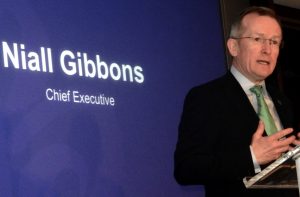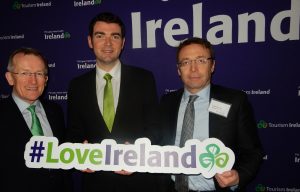
Tourism Ireland’s Chief Executive Niall Gibbons may be the most passionate Irishman ever, at least when it comes to getting people to visit the Emerald Isle. Responsible for marketing the island overseas, Gibbons has been enjoying a series of success since his appointment in June 2009 — the Brexit boondoggle notwithstanding. As Gibbon declared, “We have had such growth; where we previously had 11.2 million people visiting the island of Ireland – an impressive figure in and of itself given that the population is about six and a half million — but that went to nearly two million visitors last year.”
Maybe that’s because Gibbons and his team has been transforming the Island into a major travel destination. Historically, Ireland had been a place where descendants of the Irish Diaspora would return home to re-discover their roots, expats would come back to visit the friends and families they left behind or visitors go to experience a place which harkens back to a slower, quieter and quaint past.
As Gibbons explained about their re-imagined tourist experience, he noted, “Ireland has been diversifying its source of markets for it to be a key destination. We have our core markets; North Americans have spent about €1.9 billion, mainland Europeans are likely to spend more than €2.1 billion and British visitors have spent about €1.5. But the emerging markets, like China, have become important, and are growing very rapidly, but from a very small base. We now have air access to Hong Kong with Cathay Pacific and Beijing with Hainan Airlines, with a third China route expected to be launched in the coming months.”
Gibbons has overseen the marketing of Ireland as a tourist destination across the world, leading a staff of 150 in more than 20 markets. As the official government body tasked with promoting the island as a hospitality destination, Tourism Ireland’s senior management team not only includes the Chief Executive but also directors of three three operational divisions. So equipped with such an ardent crew, he has achieved a level of success that they hadn’t expected with those many visitors hitting the island. With such responsibilities, Gibbons has methodically found ways to not only maintain the tourists Ireland already has but has identified and been acquiring the new audiences which have been targeted.
All this comes through a man with rock-solid credits of working with all manner of people in government and business [He is pictured to the right with Tourism Minister Brendan Griffin and Consul General Ciaran Madden]. A graduate of Trinity College, Dublin, and a Fellow of Ireland’s Institute of Chartered Accountants, Gibbons is also Deputy Vice President of the of the Dublin Chamber, sits on the Export Trade Council for the Irish Government, a member of Culture Ireland’s Expert Advisory Committee and an Honorary Fellow of the Institute of Hospitality in Ireland. Prior to that, he served as Director of Corporate Services and Company Secretary of Tourism Ireland since 2002. He played a key role in the formation of Tourism Ireland and its subsequent development over the past seven years. During that time, his responsibilities have included eMarketing, Regional Marketing, Access Development and Customer Relationship Management, in addition to Finance.
Gibbons continued to outline their present strategies: “When you look at the distribution of tourists into Ireland over the last couple of years, the N orth American market has been exceptionally strong. We moved, over the past seven years, from having 10 gateways in North America to 24. If you went back 10 years ago, we just had the traditional gateways of New York, Boston and Chicago, but we now have Miami, Philadelphia, Seattle, and San Francisco. This has opened up a whole new audience for us with visitors from North America, the United States and Canada.”
orth American market has been exceptionally strong. We moved, over the past seven years, from having 10 gateways in North America to 24. If you went back 10 years ago, we just had the traditional gateways of New York, Boston and Chicago, but we now have Miami, Philadelphia, Seattle, and San Francisco. This has opened up a whole new audience for us with visitors from North America, the United States and Canada.”
The motivations of these travelers have also changed as Gibbons pointed out. “With older visitors, they came perhaps to trace their family tree, but they are being replaced with a more fleet-footed younger holidaymaker. We are finding now though that only about a third of people coming to Ireland from the States have an ancestral connection – this used to be 70%. What we have seen today suggests there is a new and emerging group of people who find Ireland interesting and are interested in coming.
Some 85 per cent of the people who arrive in Ireland do so by air, so it’s vital that we offer as many opportunities for them to find their way here. The ease of air access makes it possible for them to do so. And we are also the only country in Europe to offer United States pre-boarding, making it even easier.”
Gibbons also keenly stressed how the developing transiting market helps Ireland as a tourism destination. “Even if guests don’t leave the airport, a whole new market has opened up for Ireland, not just in those traveling to Ireland, but also with those transiting to Europe. If you take a route like Boston into Dublin — which did not run over the winter before — it now runs year-round as it serves further markets across Europe. And as Aer Lingus broadens its network, it boosts our tourism capacity from North America and Europe in ways that we did not have before.”
But there is more to come, with further expansion in mind, Gibbons continued, “There are a whole range of destinations in the United States with the capacity for expansion – places like Texas. American Airlines is opening Dallas into Dublin; it is an incredibly opportunity for Ireland. Places like Denver also have some very strong traffic, as well as places like Pittsburgh, where there are good Irish communities we could develop.”
With the British political situation politely described as “in flux,” Gibbons was quick to downplay any potential negative impact of the ongoing Brexit saga. “There are 230,000 seats every week into Ireland from the UK with eight airlines and this will not change as a result of Brexit,– whichever way it is resolved. There are ferries offering 40,000 car spaces every week and that will not change this summer either. Family links are still strong, business links are very strong, and we expect them to remain so.”
With key partners well placed to weather any storm, there are a few concerns. “We have been talking to key partners like Ryanair and Aer Lingus, and they see no impact; the same with Irish Continental Group and their brand Irish Ferries. The latter has a new ship called the MV W.B. Yeats – which is the size of a football stadium – and they’re building capacity on routes between the UK and Ireland. Tourism Ireland will also increase its spending in the UK as well. That said, we cannot be complacent, but we are confident we have the right strategy in place.
“Priority markets for the island of Ireland are Great Britain, the United States, Germany and France which together deliver the majority of overseas visitors. Programs are being rolled out for a further 18 markets across the world, including Northern and Southern Europe, Australia, New Zealand and the Middle East, as well as in key markets of the future like China and India.“
Tourism Ireland is responsible for marketing the island overseas for holiday goers and business travelers. “We deliver world-class programs in 23 markets and reach a global audience over 600 million each year. Targeted marketing activity includes online advertising, on TV and outdoor sites, in cinemas and in newspapers and magazines, eMarketing, overseas publicity, co-operative marketing with carriers and other partners and promotions to the travel trade and consumers.”
Each year, Tourism Ireland provides a wide range of opportunities to Ireland’s tourism industry partners to promote their businesses alongside us overseas. Tourism Ireland also helps to influence tourism development on the island by sharing insights on global tourism trends and the changing needs of overseas consumers with other Tourist Boards and industry partners. Said Gibbons, “The United States continues to be one of our strongest performing markets, delivering visitors who stay longer and spend more than average. Our new strategy is the result of a comprehensive review and is designed to build on recent record levels of visitor growth and identify the key opportunities and challenges ahead.”
According to Tourism Ireland’s strategies presented online and live, Gibbons et al are taking a long-term approach. The island of Ireland’s brand experiences (the Wild Atlantic Way, Ireland’s Ancient East, Dublin, the Causeway Coastal Route and Belfast) are resonating well with key US segments and offer future potential for development and growth. New research was undertaken to deepen and enrich an understanding of the journey prospective US visitors take when choosing their holiday – either to Ireland or competing destinations – which helps to map their path to purchase. This analysis has generated new insights that inform plans for the future. Given the need to develop new experiences that meet the interests of the US traveler, the broader strategy has been developed with an eight-year plan to 2025 to allow for longer term planning and capital investments.
Gibbons is excited by several new directions that are grabbing the attentions of travel consumers. “As food has become a new focus for tourism everywhere, people are discovering Ireland as a destination in that regard. It’s not just a matter of going to Dublin to eat in trendy restaurants with fine cuisine. They are discovering the fresh and wholesome quality to our food nationwide. Farm-to-table is not just a concept here, it is a daily reality and people are traveling throughout the country to try our food, visit cooking schools and farms that serve complete meals to travelers.”
Thanks to television series such as “Game of Thrones,” the category of entertainment travel has been seized upon by locals and international visitors alike. As Gibbons enthusiastically agreed, “That is a whole new opportunity for us. There are now ‘Game of Thrones’ themed tours, and those inspired by Harry Potter as well. This is a category that just keeps growing for us.”
As he acknowledged, “Capturing the attention of US consumers is not about changing technology or finding new interventions in the consumer journey. It is more about the salience of the island of Ireland and how we build and stimulate consideration. The island of Ireland must be vivid, motivating, noticeable and arresting.”
